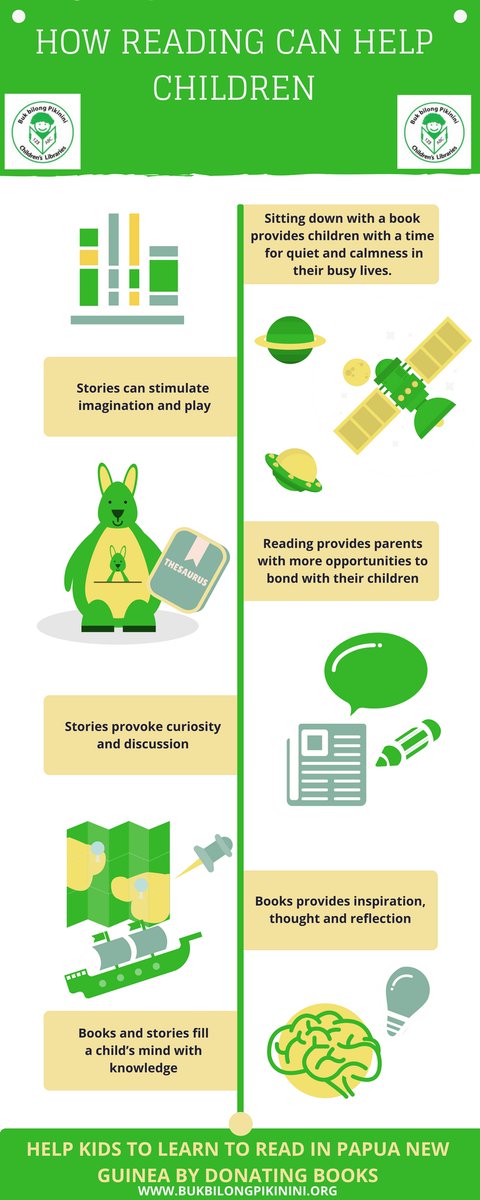I hope you find my writing and business tips and observations useful. My business and blog are dedicated to helping businesses communicate clearly and reach their potential.
Read, subscribe to my newsletter, enjoy!Tash
Why support children learning to read?
I came across this great infographic outlining why children need to be able to read.
As well as being a good message in itself, the infographic also supports Buk Bilong Piknini (a charitable organisation funding books and reading programs for children in Papua New Guinea).
What do you think – why is it important we encourage children to learn to read, and then read some more?
I would also encourage everyone to help ensure our children are literate – whether by donating to groups such as Buk Bilong Pikinini, helping at schools or giving books as gifts, every bit helps.
Helping children learn to read
I frequently help at my children’s school by listening to children (usually not my own!) read and helping them build the skills of sounding out new words, ensuring the words make sense and getting a full understanding of what they are reading.
Why do I (and many others) help these children?
- learning to read opens many opportunities for children – through learning, ideas and comprehension
- the sooner they learn to read, the easier other aspects of school become – delayed reading can limit other learning and become a downward spiral for education
- I love reading – books give me pleasure, ideas, an escape and relaxation – and I hope to share that pleasure with children
- all the children benefit by their classmates being able to read – teachers can concentrate on contact rather than reading if all students can read competently (for their age) and each child can contribute more ideas and experiences if they are well read
- seeing me place an importance of everyone being able to read, encourages all the children to value reading
- seeing people volunteer to help at school also teaches children about community spirit, generosity and being able to make positive change in small ways
What have you done to help children (or adults for that matter) learn to read and enjoy reading?
Who can read the sign?
We attended an indoor play centre recently for a child’s birthday party.
I spotted a sign on a wall opposite an inflatable slide, within the enclosed rock climbing area, that I think was missing the audience.
Where the sign was
The sign was up on a wall and printed in a large font so it should have been useful.
However, it was on an angle that made it hard to read except for by children rock climbing.
Surely putting it above the inflatable would have been more effective as it would be visible at the time you would be considering climbing up the forbidden walls.
What the sign said
Remembering this was in an indoor play centre where most of the patrons are under eight years of age, the sign was not written for the audience.
Apart from the very young children who can’t read at all, many youngsters would not be up to reading ‘inflatable’ and many would not know the word ‘banned’. Even for those who can understand the sign, it will be most effective if people get it instantly, without having to think about its meaning.
The inflatable is more known to children as the big slide, so that is the type of language they would be better using.
A much simpler sign would be “Do not climb up the slide”.
I think this is simpler and more effective, but also has a second meaning as it tells children not to climb up the slide itself, as well as not climbing on the support walls.
It is always important to know who you are aiming your communications at, and aim for clarity more than cleverness.
Communicating to potential voters
Throughout Victoria, we are about to vote for our local councils.
Unbelievably, in my ward, there are 21 candidates for us to choose from to select 3 councillors!
This is a lot of people to consider while trying to choose my vote and is a bit overwhelming but it is useful from a communications perspective as I can see big differences in their statements.
Candidates’ statements
So, putting aside politics and any particular platforms these people are standing for, here is a summary of the candidates I can choose this week. I am basing this on the official statements prepared by each candidate that were sent to us by the Electoral commission, and I am not using anyone’s real name!
group 1 – sole platform
George – has a personal dislike to something other residents are doing so wants us to vote for him to stop that behaviour.
Fred – is retired and is standing to get better deals for older residents.
Sally – is mum to young children and will fight for better services for new mums and for families.
Communications – all three of these people have written a reasonable statement that is easy enough to understand and sound like reasonable people. I just find it difficult to trust someone who is obviously going into council for their own best interests.
group 2 – political
Jenny – states she is affiliated with a major political party but lists various local issues and experience to show relevance. The second half of her statement is more formal and is about policies, sounding much more like a politician than a local councillor.
Ed – does not state any political affiliation but the statement sounds formal and like a federal election campaign piece. It is not law that candidates state they belong to a party (and follow part lines) but this is a contentious issue of late. All sounds pretty perfect really…
group 3 – mixed platforms
Rachel – the current councillor and someone who is involved in our community – and the only one most people I know have met or seen around. Her statement shows her passion, is easy to understand (both through competent writing and using approachable language and style) and ends with “I ask you to vote for me” (rather than demanding it). She covers a number of issues.
Angus – a young person who grew up in the area and covers a number of issues in his statement. Again, it is well written and readable.
Communications – there are others in this group but all of them discuss a number of issues in clear English and declare no connection with a political party.
group 4 – questionable
David – started his statement with “7 years house designing in Shanghai; Melbourne.” No, I don’t know what that means either – and as he works in the IT industry and is standing for a council role (not a council planning job!), it makes little sense.
David’s statement has many examples I could use in my bad writing posts – “Experience in retails…Involving security issue with PM…I pointed city apartment…Successfully suggested VCAT improve hearing procedure with writing hearing” {the lack of final full stop is copied by the way!}
Due to his poor written communication, I don’t understand what he is standing for – even when I can guess the meaning of a sentence, I can not be sure if he is for or against that issue!
group 5 – pushy
Simon sent a SMS to some people, outwardly to remind people of the need ot vote, but everyone I know of (and others according to local media) were irritated by this message. Simon came across as pushy and people felt their privacy had been invaded by these messages sent to private mobile phones.
Other than the SMS, Simon fitted into group 2 but I know at least two people who voted him as number 21 purely due to the SMS. As I have said at various times, being aggressive and overly confident in communications often backfires (with Australian audiences anyway).
Communicating with potential votes
Obviously, there are other ways these candidates can promote themselves to the voters but let’s limit ourselves to these statements. Because that is the only way most people in our area get information to make a choice in the elections.
There is a wide selection of writing styles – from someone who does not know how to write in English, through those who write good conversational English, to those who write formal, professional pieces. Just this choice of style will have a big impact on how voters will perceive each candidate.
Given there are 21 candidates (and apparently some areas have many more than that!), many voters will not read the statements in depth nor do other research. So the style and approachability of these statements is critical for their success.
Who to vote for?
Based purely on their communication skills as described above, who would you vote for if you lived in this area?
Who would you not vote for? This is possibly an even more important question for anyone trying to learn how to communicate effectively to get positive results.
Good communication can vary
So what is good communication?
I’m sure there would be many answers to this, but generally we mean being able to effectively give our message to another person (s).
That being the case, how do we classify something as good communication and set rules for good communications?
Communication impediments
While there are some basics that help with clear communications face to face, such as making eye contact, not interrupting and being polite, such things are not always possible and we may need to work around them.
Today I came across a blog post about communicating face to face and I was surprised and somewhat horrified by one of the tips given. Basically, the writer suggested that you should avoid stammering or stuttering as it can hinder clear communication. He did not allow that it was unavoidable for some people and implied it was just a behaviour they were choosing to exhibit.
There are impediments for some people in conventional communicating – blind people can’t meet your eyes, deaf people may focus on your lips instead of your eyes, someone with Tourette’s syndrome or Asperger’s may seem impolite and various people (including stammerers) may be harder to understand.
And yes it may be easier for us if those people did follow the ‘rules’ of good communicating, but they can’t so we have to learn to be patient and understanding. I found it insulting that this writer included ‘stop stammering’ as a means of communications.
Have you come across examples of people setting communication rules that are excluding certain groups of people? Or people with rigid ideas of what good communicating look like?
Back to basics on editing
 “It’s not fun to reread everything but you have to edit your work. I’ve written long essays at Uni, thinking they were good, but when I edited them, I found some bits just didn’t make sense. Sometimes your brain takes a little rest and you don’t write as well.”
“It’s not fun to reread everything but you have to edit your work. I’ve written long essays at Uni, thinking they were good, but when I edited them, I found some bits just didn’t make sense. Sometimes your brain takes a little rest and you don’t write as well.”
That’s what my son’s grade two teacher said this morning as she led a class on editing.
learning to edit
The ability to edit what we write is an important communication skill. For instance, if I wrote an invitation for Thursday 10pm, I may be a bit lonely at 10am when no one turn up because I hadn’t checked what I wrote in the invitation.
While it can be much easier to edit someone else’s work as it is fresh to us and we don’t have an expectation or memory of what was to be written, there are many times when doing your own editing is necessary.
Technically, learning to read and write gives us the skills to edit our work (for example, you could recognise ‘siad’ was incorrectly spelt).
However, as I saw in the classroom today, being given direct tasks for editing is an effective way to understand and undertake editing.
basic steps of editing
Each student was given a checklist of tasks to edit a piece of work they wrote last week.
The group I worked with, went through the list item by item to improve their writing. When I edit, I probably do multiple steps at once but doing one at a time is simpler for children. I also think that doing it step by step actually makes errors easier to spot.
So the checklist today was:
- title
- sizzling start
- backfill
- events in order
- does it make sense?
- check capital letters and full stops
- check spelling
Why not follow this list next time you have to edit something?
understanding the checklist
Just because this list uses very specific terms taught at our school (and others!), here are a few tips…
- not everything needs a title, but most writing that you would edit does (including an email subject as a title)
- make the beginning interesting! Primary students are taught to make a sizzling start on a simple level, but your writing should also start with something interesting
- backfill just means an introduction or explanation of the writing. Consider this the all important sentence that answers who, what, where, why and when.
- different styles of writing require differences in content, so you may not always need events to be listed in chronological order – but the order of what you do include needs to make sense in the relevant context.
- at school today, I had the students check each sentence made sense. Some had written ‘first tunnel ball. then octopus.’ which obviously needed to be more like ‘first we played tunnel ball, then played octopus.’
As more literate adults, we can read through the work faster to check for meaning. However, a slow read of each paragraph can really help spot errors.
getting help
I liked that the teacher today actually told the students to get help with editing.
First, she suggested that if they suspected (or knew!) a word was misspelt they could check the spelling by using their dictionary or asking a classmate.
Then, she also suggested that for any sentence they were unsure of, it was ok to say “Hey, Tom, does this make sense to you?” and get someone else’s opinion.
So even if you don’t get someone to edit your writing for you, you can look up or ask for help on specific sections of your work. If the writing is of importance, the editing help is really worth the effort.
Sticking to instructions
Trying something new is always challenging and a bit nerve wrecking.
So it’s easy to rely on sources of information to help the process.
Making tile adhesive
We are doing up our bathroom so needed adhesive to attach the tiles to the bathroom walls. After research, we decided to use adhesive powder rather than a pre-mixed adhesive.
To make the adhesive, it is a simple matter of mixing some of the powder with water. Of course, how much of each is somewhat important!
The packet included instructions for making the adhesive to the correct consistency. However, the instructions were to mix 20 kg with 6 litres of water.
Trying to convert those instructions into mixing usable quantities was difficult – giving a weight rather than volume of the powder was particularly difficult. Meaning our first attempt was too wet and wasn’t going to hold the tiles well enough.
Clarity in instructions
We figured out a good consistency for the adhesive, eventually, and now have some lovely tiles stuck to our walls!
But learning from others’ mistakes, here are my tips for making instructions for useful:
- Remember who the instructions are for and make them suit. That is, don’t assume the person reading the instructions knows as much about your product as you do. If you are only writing for experienced people (in our case, professional tilers), you may be able to give less information than if writing for inexperienced users (such as DIY tilers).
If you have more than one audience, ensure the instructions are simple enough for the less experienced group. - Aim for clarity so people understand how to use your instructions. You can do this through
- avoid jargon
- do multiple small steps instead of a few large steps
- use short sentences
- use simple language and sentence structure
- if the product has different uses, explain how instructions vary between those uses. For example, if floor and wall tiles need adhesive with different consistencies, say something like “Add 6 litres of water for floor tiling and 5 litres for wall tiling” rather than “depending on the consistency of the mix required”.
- Where measurements may vary, give a ratio or multiple examples. I’ll expand on that in my next post 🙂
- Put instructions where they are easily seen – not just so they can be found but so that they are easy to refer to whilst using them. Again, with the tile adhesive packet, the mixing instructions were in amongst paragraphs of text.
What interesting experiences have you had with hard to understand instructions?
Digital financial communications
What do you do with the annual reports, product disclosure statements and other disclosure materials you’re sent by banks, super funds and similar organisations?
Hard copy rubbish
If you’re like many people, you put them in the recycling (or normal) bin – possibly without even reading it first.
This is annoying because
- it is a waste of paper and thus a burden on the environment
- it is a waste of money to print and mail the documents – and guess who pays for that waste?
Going digital
 A few years ago, legislation changed so that financial instructions can send some disclosure information electronically. That could be as an email attachment, an email linking to an online resource or even an SMS containing a link.
A few years ago, legislation changed so that financial instructions can send some disclosure information electronically. That could be as an email attachment, an email linking to an online resource or even an SMS containing a link.
However, the super funds and banks could only do this if you consented to getting it electronically.
New digital rules
Under a new ASIC guidance, financial organisations in Australia can send disclosure materials to their customers/members by default.
That is, they will need to notify customers/members that “certain information will be provided by {explain electronic method} unless you opt out within 7 days of this notice.”
So once such organisations set up this notification and opt out system, we can all expect to receive such notices and then get fewer hard copy disclosure materials.
Going back to my first question – do you keep hard copies of such materials? If so, will you opt out of electronic communications now there is a clear choice?
If you were a financial organisation, would you swap to sending digital communications instead of hard copies?
Control pop up ads
I just visited a blog for the first (and probably last!) time.
As soon as I got to the URL, a pop up opened to promote something I assume they get a commission or payment for. There was a x on the pop up so I was able to close it fairly easily at least.
I hate pop ups at the best of times (and am annoyed that many get past pop up blockers but that’s another story!) so it doesn’t make me like a site when I get a pop up so quickly. But I sigh and move on.
Frequency of pop ups
On this particular site, I closed the pop up and then clicked on a link to see the most recent blog post.
As soon as the blog post opened, so did another pop up.
As soon as the about us page opened, so did another pop up.
As soon as the registration page (clicked on by mistake!) opened, so did another pop up!
Seeing the same pop up that many times is NOT making me more likely to click on it let alone spend money on whatever is being advertised.
Topics of pop ups (and other ads)
I understand that running a blog has costs and people want to make a bit of money back from their blog if possible. Ads and affiliate links are one way to cover some blogging costs.
But surely it’s more effective if the ads are aimed at the target audience of the blog?
In my example above, the site is about cooking but the pop up was about web hosting.
Obviously, some people are interested in both cooking and running a website. But can you assume most people looking up recipes and cooking tips will be interested in hosting a website?
I think a pop up for cooking books, online shops for herbs and other ingredients, or even online retailers of cooking tools would interest more of the blog’s visitors. And thus earn the blogger more money – or the advertiser more relevant exposure.
The lesson learned?
Ok, I already knew this but the lesson from my example is to control any pop up advertising on your blog or website.
- only show the ad a few times – if someone says no after that, they’ll probably always say no
- make your ads relevant to your audience. If not immediately apparent why it should interest that audience, make the ad itself provide a link.
So what do you think of website pop ups?
Do you use (and hopefully control) pop ups on your site? If so, what response have you got from them?








Recent Comments